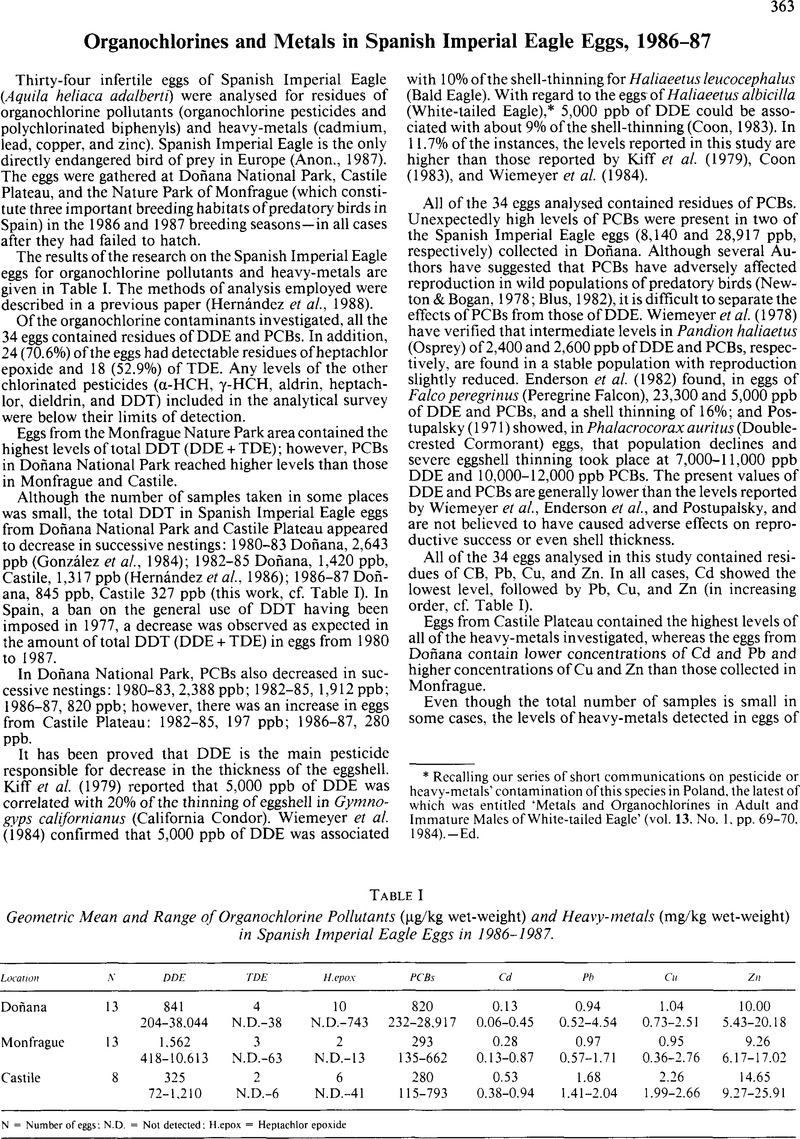Crossref Citations
This article has been cited by the following publications. This list is generated based on data provided by Crossref.
Fernandez, M. A.
Hernandez, L. M.
Gonzalez, M. J.
and
Tabera, M. C.
1992.
Organochlorinated compounds and selected metals in waters and soils from Do�ana National Park (Spain).
Water, Air, & Soil Pollution,
Vol. 65,
Issue. 3-4,
p.
293.
Fernández, M.A.
Hernández, L.M.
Ibánñez, C.
González, M.J.
Guillén, A.
and
Pérez, J.L.
1993.
Congeners of PCBs in three bat species from Spain.
Chemosphere,
Vol. 26,
Issue. 6,
p.
1085.
Burger, Joanna
1994.
Heavy metals in avian eggshells: Another excretion method.
Journal of Toxicology and Environmental Health,
Vol. 41,
Issue. 2,
p.
207.
Pain, D.J
Sánchez, A
and
Meharg, A.A
1998.
The Doñana ecological disaster: Contamination of a world heritage estuarine marsh ecosystem with acidified pyrite mine waste.
Science of The Total Environment,
Vol. 222,
Issue. 1-2,
p.
45.
Mateo, R.
Cadenas, R.
Máñez, M.
and
Guitart, R.
2001.
Lead Shot Ingestion in Two Raptor Species from Doñana, Spain.
Ecotoxicology and Environmental Safety,
Vol. 48,
Issue. 1,
p.
6.
Taggart, M.A.
Figuerola, J.
Green, A.J.
Mateo, R.
Deacon, C.
Osborn, D.
and
Meharg, A.A.
2006.
After the Aznalcóllar mine spill: Arsenic, zinc, selenium, lead and copper levels in the livers and bones of five waterfowl species.
Environmental Research,
Vol. 100,
Issue. 3,
p.
349.
Hernández, Mauro
González, Luis M
Oria, Javier
Sánchez, Roberto
and
Arroyo, Beatriz
2008.
Influence of contamination by organochlorine pesticides and polychlorinated biphenyls on the breeding of the Spanish Imperial Eagle (Aquila adalberti).
Environmental Toxicology and Chemistry,
Vol. 27,
Issue. 2,
p.
433.
Carneiro, Manuela
Colaço, Bruno
Colaço, Jorge
Faustino-Rocha, Ana I.
Colaço, Aura
Lavin, Santiago
and
Oliveira, Paula A.
2016.
Biomonitoring of metals and metalloids with raptors from Portugal and Spain: a review.
Environmental Reviews,
Vol. 24,
Issue. 1,
p.
63.
Hernández, Mauro
Colomer, Ma Àngels
Pizarro, Manuel
and
Margalida, Antoni
2018.
Changes in eggshell thickness and ultrastructure in the Bearded Vulture (Gypaetus barbatus) Pyrenean population: A long-term analysis.
Science of The Total Environment,
Vol. 624,
Issue. ,
p.
713.



